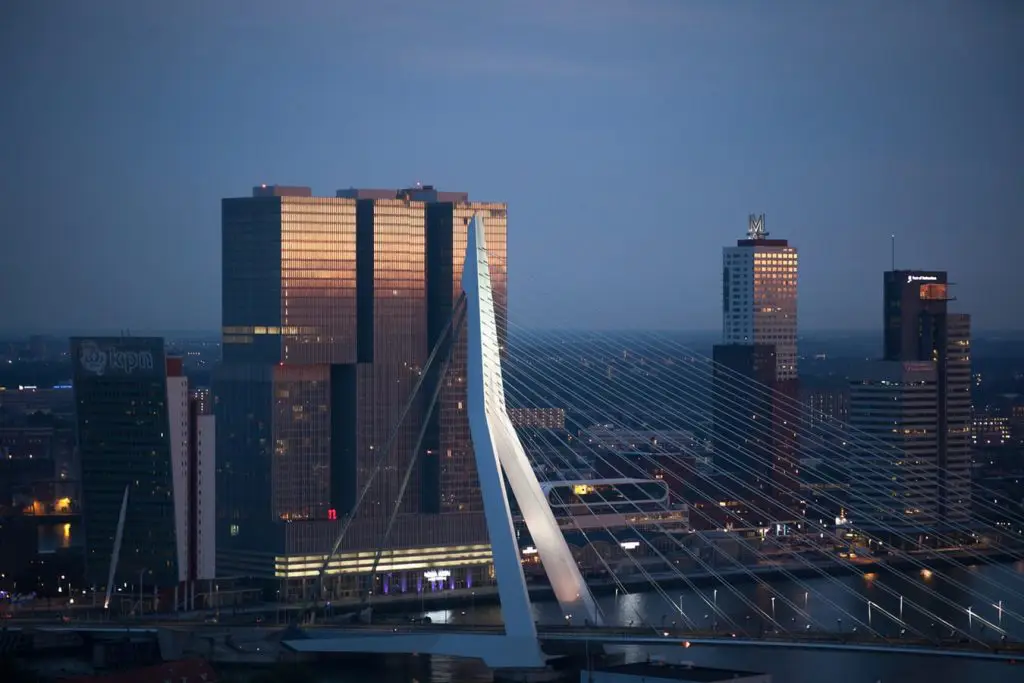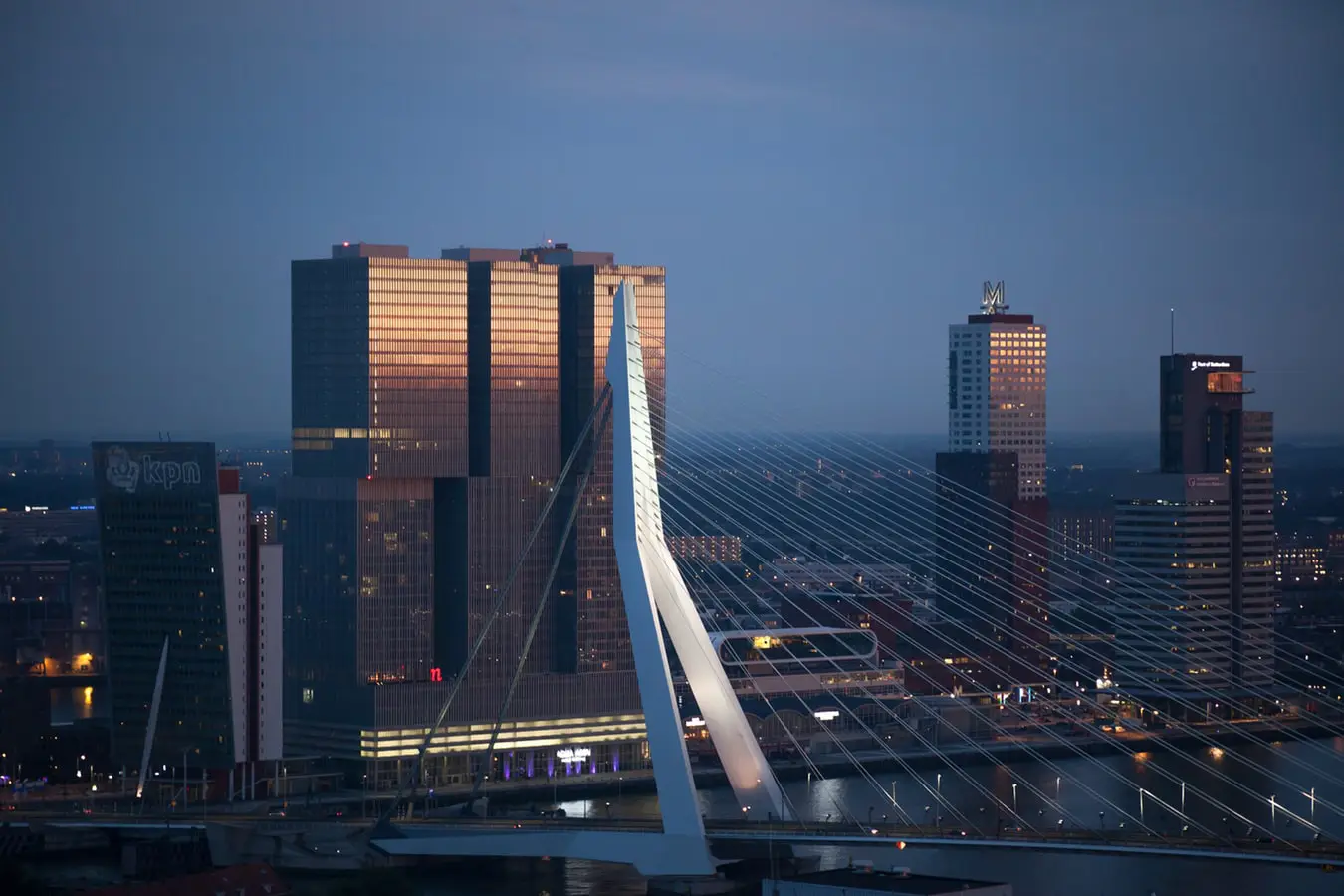Expert travel storyteller Jordan Adkins, founder of InspiredByMaps.com, brings a decade of adventures across 101 countries and 450+ UNESCO sites into rich, off-the-beaten-path narratives, melding ecological expertise with genuine, seasoned travel insights. His full bio can be found here.
Rotterdam is the second-largest city in the Netherlands, after Amsterdam to the north. It is often considered as the business-like younger brother of A’dam; a commonly uttered phrase is that “Money is made in Rotterdam, and spent in Amsterdam”.
Rotterdam seems, at first glance, a city that only focuses on modernity and business. However, this can’t be farther from the truth; the traditions and people that makeup ‘the other ‘Dam’’ are alive and on display.
No doubt, this is a wonderland of modernist architecture; one of the few cities to boast skyscrapers and Michelin stars without a massive urban population. Rotterdam is an amazing city to visit if you only have one day, the perfect mix of modern and classical.

What To Do In One Day In Rotterdam | The Ultimate 24 Hour Guide!
Page Contents
History And Character Of Rotterdam
The region of modern-day Rotterdam saw periodic inhabitation for over 1000 years; an extended settlement was only prevented by frequent flooding in the low countries (Netherlands). A dam was built on the river Rotte (or Rotta, meaning ‘muddy water’) in 1270, providing protection for the development of a permanent settlement. This dam remains as the Hoogstraat area of the modern city.
Over the following 500 years, the town saw slow but steady growth. The end of the 19th century was marked by a massive expansion of the city and its population. This prompted the founding of Erasmus University in 1913, named after famed resident Desiderius Erasmus. The institution is consistently ranked in the global Top 50 for Finance, Business, and Medicine.
World War 1 largely spared Rotterdam due to the neutral stance of the Netherlands throughout the calamity. The city actually played host to the densest population of spies in Europe, easily accessible from the UK, France, Belgium, and Germany. The conflict prompted an influx of new residents, mainly Belgian refugees, German pacifists, and Allied prisoners-of-war.
Hitler was not so kind to Rotterdam. The Nazi’s saw strong resistance when trying to invade the Netherlands – they decided to make a display of force. The Rotterdam Blitz destroyed most of the structures in the city center, similar to nearby Eindhoven and Dusseldorf, and prompted the Dutch surrender days later. The assault required Rotterdam to rebuild from ruins.
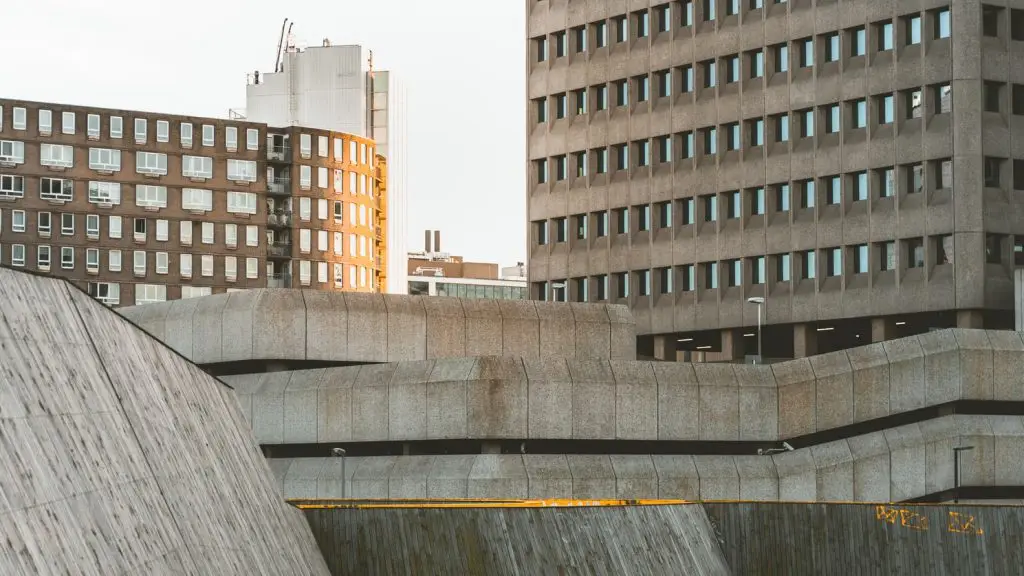
Geography And Climate Of Rotterdam
Rotterdam’s unique location on the North Sea has garnered it the title of ‘Gateway to Europe’, or in the other direction, ‘Gateway to the World’.
The city is near the confluence of some of the most famous rivers on the continent: the Rhine, Meuse, and Scheldt. These waterways connect deep into the heart of western Europe, making Rotterdam a frequent stop in either direction. This strategic location has resulted in the city developing into Europe’s largest port.
The city expanded from a central point on both sides of the Nieuwe Maas River. This resulted in Rotterdam being largely split down the middle; the North and South are connected by at least four tunnels and four more bridges. Most of the city is located North of the river, however, the Southside has been expanding quickly since the 1990s, after the construction of the Kop van Zuid.
The plethora of waterways surrounding the city, along with the elevation being near sea level, give Rotterdam a temperate oceanic climate. This means that winters are cool with a few cold days, but rarely below -5°C; summers are mild to warm, temperatures above 30°C are not particularly rare.
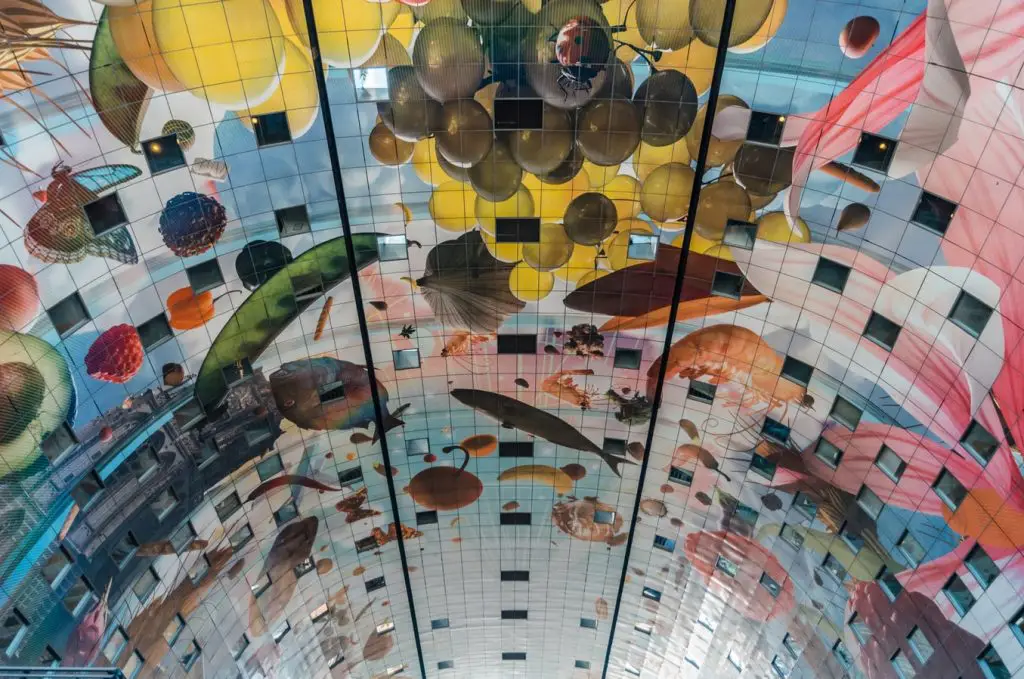
Atmosphere And Approach To Rotterdam
While Rotterdam may seem all business, it is still quite a small city, with less than one million residents. The majority are immigrants, with foreign-born residents outnumbering the Dutch in the city center. Over 20% of the city’s population comes from Suriname, Turkey, and Morocco alone.
This multiculturalism as led to competition with Amsterdam as the cultural capital of the Netherlands. The Rotterdam Philharmonic, the local orchestra, is held in high esteem and often compared to its regional counterparts.
The city is also known for its large festivals: their Caribbean Carnival (Zomercarnaval) is the 2nd largest in Europe, with other events celebrating dance, pop music, film, poetry, and jazz.

The prevailing ‘professional’ vibes of the city has attracted many young people; 70% of people between the ages of 20 to 40 are single, as of 2018. This population, often with disposable income, has prompted the development of many shopping streets and complexes:
- Lijnbaan is a pedestrian-only shopping street with a vast selection of wares
- Hoogstraat, or High Street, is built over the remnants of the old dam over the Rotte river
- Coolsingel houses many shops, as well as the elegant City Hall
- Beurstraverse, nicknamed the Koopgoot (‘buying gutter’) for it being mainly underground
- Kruiskade is where the upscale shops reside, with posh brands represented

Culinary Attractions Of Rotterdam
Rotterdam doesn’t have many food traditions unique to itself, it combines and glorifies the national dishes of the Netherlands alongside the international cuisine brought by immigrants. Frankly, if you’re feeling adventurous, choosing a place to eat at random is often to please and rarely disappoints.
However, aside from what might seem like too much selection, Rotterdam is known for a selection of world-class markets. The Markethal is a breathtakingly huge, permanent market, with over 100 stalls and restaurants. Here you can sample the best of Dutch comfort foods and find trinkets and souvenirs to bring home.
The Witte de Withstraat is a popular district for diners and tourists alike, worth visiting both during the day and at night, for markedly different vibes. If you’re looking for something unforgettable, there are at least five Michelin-starred restaurants scattered throughout the city, with most situated around the shopping districts mentioned above.
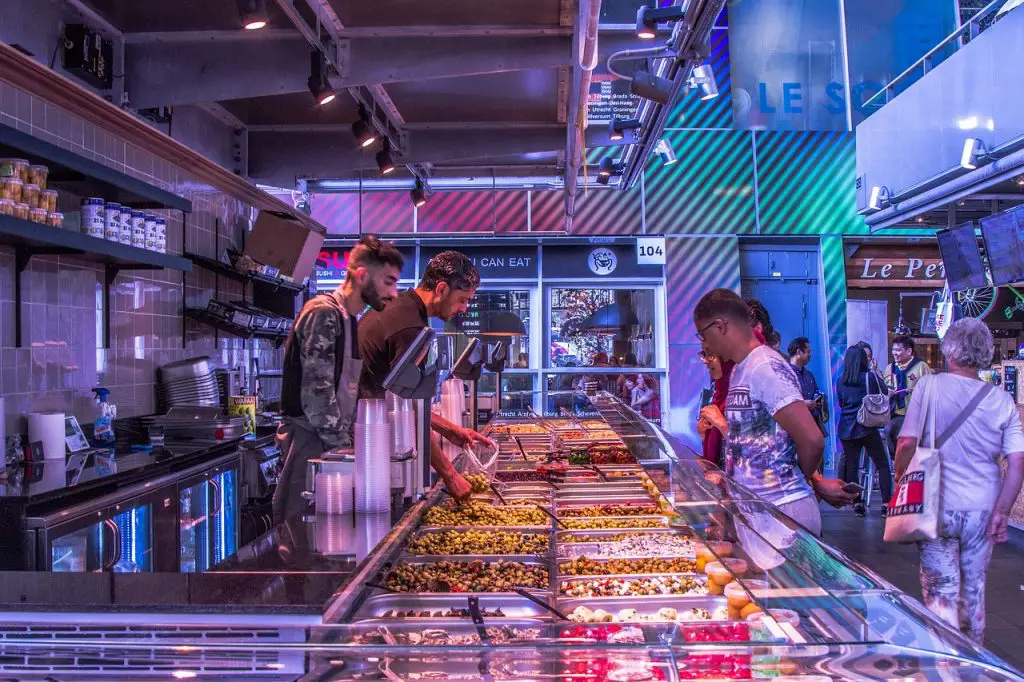
Rotterdam In A Day
Rotterdam is a modern city, especially captivating for lovers of recent architecture. However, there are still a few traditional buildings that remain in the wake of WW2, where you can explore the classical underpinnings of this contemporary and cosmopolitan city.
- Euromast: An observation tower, built in the late 1950s, that affords splendid views of the Rotterdam skyline. It rises 96 meters over the streets and contains an observation tower and restaurant. The 85 meters ‘Space Tower’ on top, added in 1970, makes it the tallest building in the city.
- Erasmusbrug: The Erasmus Bridge can easily be seen from the Euromast and most of the waterfront. Finished in 1996, it spans 790 meters across the river, stretching to 138 meters at the highest point of its oddly-shaped, pale blue pylon. The abstract, modern design, and characteristic shape, has earned it the nickname of ‘Swan’.
- Markthal: The Market Hall is a massive residential and commercial building, wrapped around an enormous public market. The structure itself is a testament to engineering, before even entering into the mural-laden and naturally-lit space. The artwork that plasters the walls has earned it the names of Largest Artwork in the World, and the Sistine Chapel of Rotterdam.
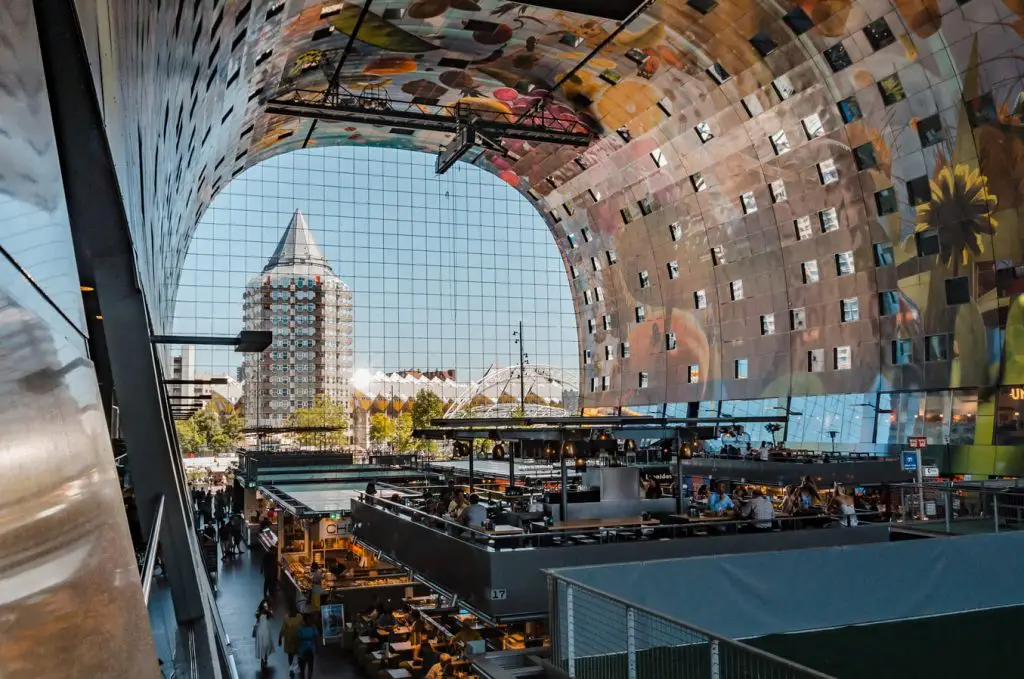
While the Markthal has plentiful options to quell your hunger, there are endless opportunities throughout the city to satisfy a craving for something specific. From wholesome noodles to Michelin stars, there’s surely something for everyone.
- Hinoki Noodle Shop: Just a few hundred meters away from the Markthal, you’ll recognize Hinoki by the long line that usually flows from the door. If you’re lucky, you may get in quickly; either way, the service is always prompt. Claimed by many to be the best noodles in the city, these hearty bowls will fuel you for the rest of the day.
- Joelia: Housed in the Hilton Hotel, Joelia received their first Michelin star not long after opening in 2016. An experience here requires a reservation, but it exemplifies the modern luxury and sophistication that Rotterdam is known for. Expect to spend some time, and loosen the wallet, but your time there will be unforgettable.

After satisfying your culinary cravings, you can spend the rest of the day wandering the beautiful streets of Rotterdam. Thankfully, many of the remaining highlights of the city are all within a few blocks of each other. Visiting these landmarks will bring you through some of the nicest and most affluent parts of the city.
- Witte Huis: Built-in 1898, it was the first hoogbouw (‘high-rise’) in Europe, at a majestic 43 meters tall. It’s an exemplar of the Art Nouveau style and is now listed as a national monument. The ground floor houses some cafes and bars that make good use of the luxurious atmosphere and unique architecture.
- Grote of Sint-Laurenskerk: The Church of St. Lawrence is the last remnant of medieval Rotterdam. It was built between 1449 and 1525, the first all-stone building in the city. It has seen renovations and damage throughout the centuries, especially during WW2, but is now open to the public for mass and services.
- Stadhuis: The Town Hall was constructed largely during WW1 and is one of the few classic buildings to survive to this day. It is heavily influenced by the Beaux-Arts style, combined with aspects of Roman and Art Deco influence. The Hall contains art from many styles and ages, definitely worth a view to understand the history of Rotterdam.
And there you have it, a fabulous day in Rotterdam – with all of the top highlights. Of course, if you have more energy in the evening there is wildlife that is as inhibited as the other top spots in Europe – Amsterdam, Vienna, London, Stockholm – so if you are tempted…well, we would never judge you…
